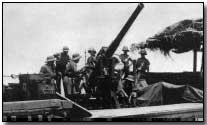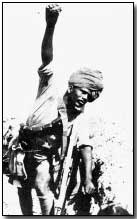Battles - The Battle of Hanna, 1916
 Having failed twice
earlier in the month
of January 1916 to relieve
Sir Charles
Townshend's beleaguered force at
Kut-al-Amara, General
Aylmer was nevertheless ordered by
Sir John Nixon,
the regional British Commander in Chief, to continue with his increasingly
unsuccessful operation.
Having failed twice
earlier in the month
of January 1916 to relieve
Sir Charles
Townshend's beleaguered force at
Kut-al-Amara, General
Aylmer was nevertheless ordered by
Sir John Nixon,
the regional British Commander in Chief, to continue with his increasingly
unsuccessful operation.
Aylmer's force of 10,000 men, in order to reach Kut, was travelling upstream on the River Tigris. Blocking his way were some 30,000 Turkish troops commanded by the increasingly confident Khalil Pasha. With the Turks sited on the Hanna Defile slightly upstream from the Wadi - now in British hands - Aylmer could not hope to relieve Townshend without first defeating Khalil's force.
Thus on 21 January 1916 - a bare week after his last failure during the Battle of the Wadi, and coming after subsequent repeated attempts in heavy rain (during the flooding season) to take the Hanna Defile, all ending in dismal failure, Aylmer launched a fresh attack.
Nixon had days earlier vetoed Aylmer's suggestion - supported by Townshend (who had also announced he had fewer than three weeks of rations remaining) - suggesting the latter arrange for his healthy troops to escape from Kut by boat and attack Khalil's force from behind, leaving the sick and wounded behind at the Kut garrison.
 Aylmer's
attack began with an advance by 4,000 troops of 7th Division, preceded by short
artillery bombardments at noon on 20 January and on the morning of 21 January.
The sole effect of the weak bombardment - which fired a miserly 12,000 rounds -
was to warn Khalil of an approaching attack.
Aylmer's
attack began with an advance by 4,000 troops of 7th Division, preceded by short
artillery bombardments at noon on 20 January and on the morning of 21 January.
The sole effect of the weak bombardment - which fired a miserly 12,000 rounds -
was to warn Khalil of an approaching attack.
Consequently around 60% of the attacking British force - advancing through a No Man's Land deep in 600 yards of water - was cut down by carefully sited machine gun positions. No ground was gained.
Intending to resume the attack on the following day General Aylmer called off operations once he witnessed at first hand the critical condition of his force's injured and sick. The failed attack had resulted in a further 2,700 British casualties. Medical supplies were, as ever during the Mesopotamian campaign, pitifully under-provided.
Aylmer decided that it was becoming impossible to arrange relief for Townshend's force. His force of less than 10,000 was now outnumbered by at least five-to-one in the area; he therefore saw no possibility of success. Incoming regional Commander-in-Chief Sir Percival Lake - replacing Nixon through illness - nevertheless ordered Aylmer to try again, at the Battle of Dujaila.
Click here to view a map charting operations in Mesopotamia through to 1917.
Photographs courtesy of Photos of the Great War website
"Coffin Nails" was a term used by British soldiers to describe cigarettes.
- Did you know?
